Attributes Youth, martyrdom | Feast March 24 Canonized 1575 (approximate) Name Simon Trent | |
 | ||
Patronage Children, kidnap victims, torture victims Died March 21, 1475, Trento, Italy | ||
Simon of Trent (German: Simon Unverdorben ("Simon Immaculate"); Italian: Simonino di Trento); also known as Simeon; (1472 – March 21, 1475) was a boy from the city of Trent, Prince-Bishopric of Trent, whose disappearance and murder was blamed on the leaders of the city's Jewish community, based on his dead body allegedly being found in the cellar of a Jewish family's house.
Contents
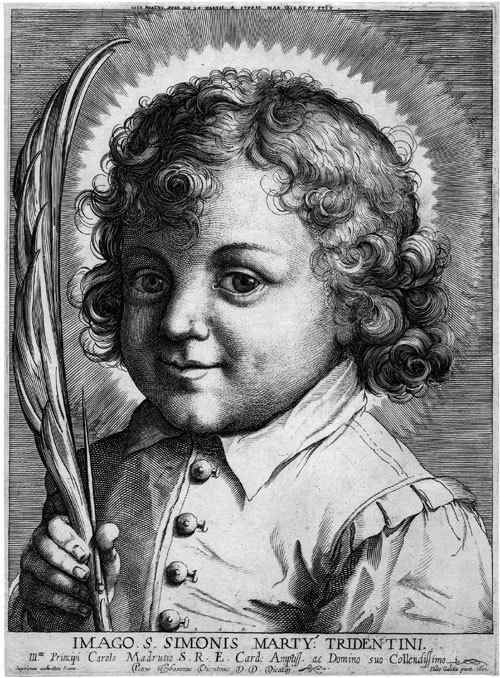
Events
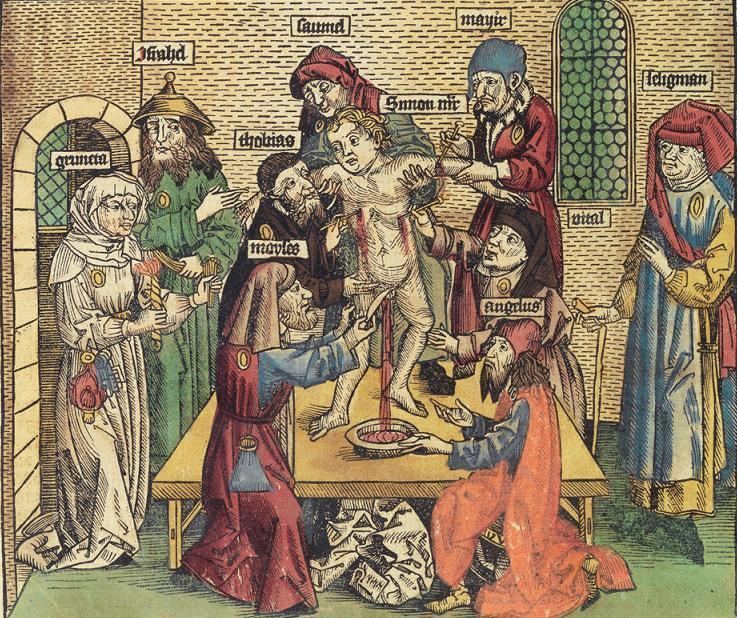
The story of Simon of Trent belongs to the reign of Prince-Bishop Johannes IV Hinderbach, an Austrian noble, under the jurisdiction of Holy Roman Emperor Frederick III. Shortly before Simon went missing, Bernardine of Feltre, an itinerant Franciscan preacher, had delivered a series of sermons in Trent in which he vilified the local Jewish community.
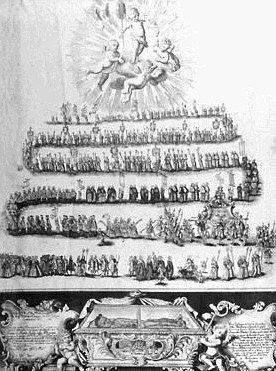
The Jewish community in Trent was composed of three households: Samuel, Tobias, and Engel, who were recent immigrants with Samuel first arriving in 1461. With Samuel as a money lender and Tobias as a physician, the Jews remained distinctly separate not only due to their profession, but their apparent wealth in a community of artisans and sharecroppers in Trent. Prince-Bishop Hinderbach specifically granted the Jewish community permission to reside and practice their professions in Trent. This dependence on the protection of the authorities, later forced the Jews, upon discovery of Simon's body, to report the incident.
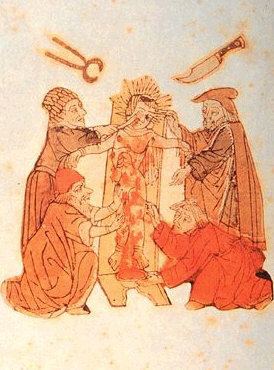
Simon went missing on March 24, 1475 and was discovered by Seligman, a cook, in the cellar of Samuel on Easter Sunday 1475.
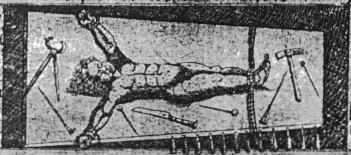
According to historian Ronnie Po-chia Hsia:
"On Easter Sunday 1475, the dead body of a 2-year-old Christian boy named Simon was found in the cellar of a Jewish family's house in Trent, Italy. Town magistrates arrested eighteen Jewish men and five Jewish women on the charge of ritual murder — the killing of a Christian child in order to use his blood in Jewish religious rites. In a series of interrogations that involved liberal use of judicial torture, the magistrates obtained the confessions of the Jewish men. Eight were executed in late June, and another committed suicide in jail".:The exact place where the boy's body was found seems to be unclear. According to the Catholic historian Cölestin Wolfsgrüber, the body was found in a ditch.
The consequences, however, are well documented. The entire Jewish community (both men and women) were arrested and forced to confess under torture. Not only were they coerced to admit to the crime of murdering the child, but also to blood libel, or the accusation that due to Jewish contempt for Christianity, Jews murder Christian children in order to use their blood for rituals. The historian Po-Chia Hsia argues that this was the first documentation of a Christian ethnography of Judaism. The forced confessions were a way for the magistrates to document the history and meanings of Jewish rituals, providing evidence for Christian belief of Jewish hatred for Christianity.
Fifteen of them, including Samuel, the head of the community, were sentenced to death and burnt at the stake. The Jewish women were accused as accomplices, but argued their gender in the domestic sphere did not allow them to participate in the rituals which were masculine matters. Later, they were freed from prison in 1478 due to papal intervention. One Jew, Israel, was allowed to convert to Christianity for a short while, but was arrested again as a result of other Jews confessing he was part of the Passover Seder and after a long period of torture was also sentenced to death on January 19. The widespread trial at Trent inspired a rise in Christian violence towards Jews within the surrounding areas of Veneto, Lombardy, and Tirol, as well as accusations of ritual murder, culminating with the prohibition of Jewish money lending in Vicenza in 1479 and the expulsion of Jews in 1486.
Pope Sixtus IV commanded Bishop Hinderbach on August 3 to again suspend proceedings, until the arrival of the papal representative, Bishop Giovanni Battista dei Giudici of Ventimiglia, who, jointly with the Bishop of Trent, would conduct the investigation. After making an investigation, the papal agent denied the martyrdom of the child Simon and disputed the occurrence of a miracle at his grave. When Bishop Dei Giudici demanded the immediate release of the Jews he was denounced by Hinderbach and assailed by the mob, and withdrew to Rovereto. Thence, he summoned the bishop and the podestà to answer for their conduct. Instead of appearing, Bishop Hinderbach answered by a circular, directed to all churchmen describing the martyrdom of Simon, justifying his own share in the proceedings, and denouncing the work of the Bishop of Ventimiglia as pro-Jewish. While the papal commissary was taking Enzelin, the supposed actual murderer, a prisoner to Rome for trial, the Bishop of Trent and the podestà continued their proceedings against the Jews, several of whom they executed.
Pope Sixtus appointed a commission of six cardinals to investigate the proceedings later in the 1475. The head of the commission was a close friend of Bernardinus. Two envoys were sent to Rome by Hinderbach in order to update the Prince-Bishop on the papal opinion. Through endless defense of the martyrdom of Simon and obtaining the support of various clergy, on June 20, 1478, the commission concluded that the trial had been conducted in keeping with legal procedures and Sixtus IV released a papal bull stating the innocence of Hinderbach, but also reasserted papal protection of Jews and the unlawfulness of ritual murder trials.
Centuries later, historian Ariel Toaff, in his book Pasque Di Sangue (Passovers of Blood), hypothesized that there may be some historical truth to the accusations in Trent. The book was heavily criticized for giving credence to testimony obtained during torture and was pulled from circulation and redacted by its author.
Veneration
Meanwhile, Simon became the focus of attention for the local Catholic Church. The local bishop, Hinderbach of Trent, tried to have Simon canonized, producing a large body of documentation of the event and its aftermath. Over one hundred miracles were directly attributed to Saint Simon within a year of his disappearance, and his cult spread across Italy, Austria and Germany. However, there was initial skepticism and Pope Sixtus IV sent the Bishop of Ventimiglia, a learned member of the Dominican Order, to investigate. The saint was officially canonized by the Church in 1475 by Pope Sixtus IV. The veneration was reinvigorated in 1588 by the Franciscan Pope Sixtus V. Simon was eventually considered a martyr and a patron of kidnap and torture victims. His entry in the old Roman Martyrology for March 24 read: Tridénti pássio sancti Simeónis púeri, a Judǽis sævíssime trucidáti, qui multis póstea miráculis coruscávit. ("At Trent, the martyrdom of the boy St. Simeon, who was barbarously murdered by the Jews, but who was afterwards glorified by many miracles.")
In 1758, Cardinal Ganganelli (later Pope Clement XIV, 1769-1774) prepared a legal memorandum which, to the exclusion of all other allegations of ritual murders of infants which records were thoroughly made available to him, expressly admitted as proven only two: that of Simon of Trent and that of Andrea of Rinn. At the same time, he remarkably extols the glories and accomplishments of the Jewish people across history, writing that the murder of Simon of Trent does not suffice to injure the reputation of the entire Jewish people.
Pope Paul VI, for pastoral reasons, removed Simon from the Roman Martyrology in 1965. Simon of Trent does not appear in the new Roman Martyrology of 2000, nor on any modern Catholic calendar. This does not mean St. Simon is no longer considered a saint by the Church, only that his veneration is now considered private rather than public.
